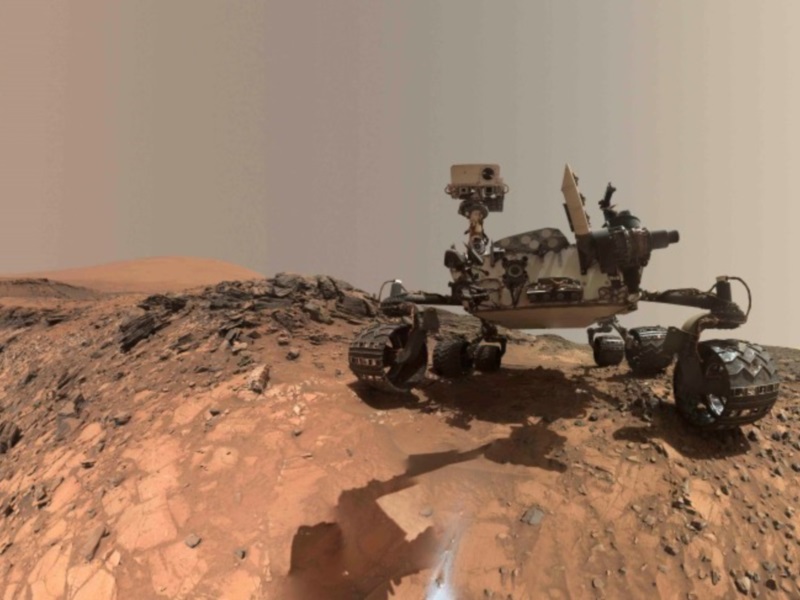- Home
- Science
- Science News
- Curiosity Measures Seasonal Patterns in Mars Atmosphere
Curiosity Measures Seasonal Patterns in Mars Atmosphere

Curiosity this week completed its second Martian year since landing inside Gale Crater nearly four years ago. The repetition helps distinguish seasonal effects from sporadic events, Nasa's Jet Propulsion Laboratory said in a statement.
Each Martian year - the time it takes the Red Planet to orbit the sun once - lasts 687 Earth days.
Measurements of temperature, pressure, ultraviolet light reaching the surface and the scant water vapour in the air at Gale Crater show strong, repeated seasonal changes, the statement added.
Monitoring the modern atmosphere, weather and climate fulfills a Curiosity mission goal supplementing the better-known investigations of conditions billions of years ago.
Back then, Gale Crater had lakes and groundwater that could have been good habitats for microbes, if Mars has ever had any.
Today, though dry and much less hospitable, environmental factors are still dynamic, the statement added.
Curiosity measured air temperatures from 15.9 degrees Celsius on a summer afternoon, to minus 100 degrees Celsius on a winter night.
"Curiosity's weather station has made measurements nearly every hour of every day, more than 34 million so far," said Curiosity project scientist Ashwin Vasavada of Nasa's Jet Propulsion Laboratory, Pasadena, California.
"The duration is important, because it's the second time through the seasons that lets us see repeated patterns," Vasavada noted.
The similar tilts of Earth and Mars give both planets a yearly rhythm of seasons. But some differences are great, such as in comparisons between day and night temperatures.
Even during the time of the Martian year when temperatures at Gale Crater rise above freezing during the day, they plummet overnight below minus minus 90 degrees Celsius, due to the thin atmosphere.
Also, the more-elliptical orbit of Mars, compared to Earth, exaggerates the southern-hemisphere seasons, making them dominant even at Gale Crater's near-equatorial location.
"Mars is much drier than our planet, and in particular Gale Crater, near the equator, is a very dry place on Mars," German Martinez, Curiosity science-team collaborator at the University of Michigan, Ann Arbor.
"The water vapor content is a thousand to 10 thousand times less than on Earth," Martinez said.
While continuing to study the modern local environment, Curiosity is investigating geological layers of lower Mount Sharp, inside Gale Crater, to increase understanding of ancient changes in environmental conditions, Nasa said.
Get your daily dose of tech news, reviews, and insights, in under 80 characters on Gadgets 360 Turbo. Connect with fellow tech lovers on our Forum. Follow us on X, Facebook, WhatsApp, Threads and Google News for instant updates. Catch all the action on our YouTube channel.
Related Stories
- Samsung Galaxy Unpacked 2025
- ChatGPT
- Redmi Note 14 Pro+
- iPhone 16
- Apple Vision Pro
- Oneplus 12
- OnePlus Nord CE 3 Lite 5G
- iPhone 13
- Xiaomi 14 Pro
- Oppo Find N3
- Tecno Spark Go (2023)
- Realme V30
- Best Phones Under 25000
- Samsung Galaxy S24 Series
- Cryptocurrency
- iQoo 12
- Samsung Galaxy S24 Ultra
- Giottus
- Samsung Galaxy Z Flip 5
- Apple 'Scary Fast'
- Housefull 5
- GoPro Hero 12 Black Review
- Invincible Season 2
- JioGlass
- HD Ready TV
- Laptop Under 50000
- Smartwatch Under 10000
- Latest Mobile Phones
- Compare Phones
- Realme P4x 5G
- OnePlus Ace 6T
- OPPO A6x 5G
- Samsung Galaxy Z TriFold
- Poco F8 Ultra
- Poco F8 Pro
- Huawei Mate 80 RS Master Edition
- Huawei Mate 80 Pro Max
- Asus ProArt P16
- MacBook Pro 14-inch (M5, 2025)
- Poco Pad M1
- Poco Pad X1
- Just Corseca Skywatch Pro
- Honor Watch X5
- Acerpure Nitro Z Series 100-inch QLED TV
- Samsung 43 Inch LED Ultra HD (4K) Smart TV (UA43UE81AFULXL)
- Asus ROG Ally
- Nintendo Switch Lite
- Haier 1.6 Ton 5 Star Inverter Split AC (HSU19G-MZAID5BN-INV)
- Haier 1.6 Ton 5 Star Inverter Split AC (HSU19G-MZAIM5BN-INV)

















